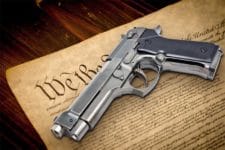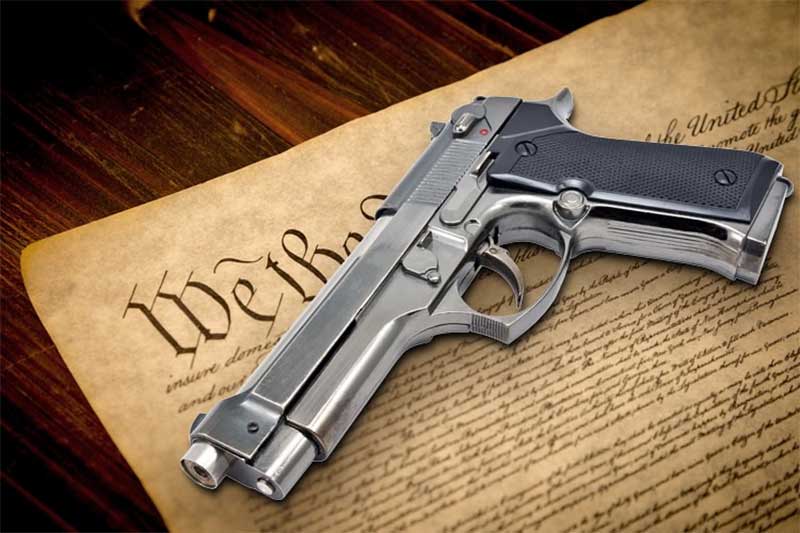
Arizona -(Ammoland.com)- The natural right to bear arms includes the right to carry them concealed as well as openly. Both types of carry were practiced at the time of the ratification of the Bill of Rights. Flintlock “muff pistols” were widely available before 1791. Daggers, dirks and other assorted blades were commonly carried concealed. Sword canes conceal the blade inside of the cane, and are considered concealed weapons. They were commonly available. They became popular, in part, to avoid any social reproach against the carry of swords, anticipating the condemnation of open carry today.

The Second Amendment does not differentiate between concealed and openly carried arms. Such differentiation was not discussed during the debates about the Second Amendment. It was decades after the Bill of Rights was ratified that concealed carry was questioned. Arms technology had not changed significantly.
Concealed weapons had and have military purposes. General Gage, the British Officer in charge of occupied Boston, had his officers conceal their sidearms when patrolling to prevent Paul Revere’s ride. From William Diamond’s Drum page 94:
And finally, unbeknown to him. Gage had that afternoon posted mounted officers, with their sidearms concealed as though they were on pleasure jaunts, along the Cambridge roads, just in case messengers should try to give out alarms that night.
There were no colonial statutes that separated the carrying of concealed weapons from the open carrying of weapons.
The Kentucky legislature passed a statute forbidding concealed arms in 1813. It was challenged in court.
The statute was found unconstitutional in Bliss v. Commonwealth of Kentucky, in the state Supreme Court. It was 1822, three decades after the Second Amendment was ratified. Any restriction on bearing arms was contrary to “the right of the citizens to bear arms in defense of themselves and the state“, and was therefore void.
The court reasoned that any diminution of the right that existed when the Constitutional protection was adopted, was an infringement of the right, and was therefore unconstitutional. The logic is impeccable.
In 1833, the Supreme Court ruled that the Bill of Rights, including the Second Amendment, did not apply to the states.
In 1833, the Indiana Supreme Court ruled that concealed carry could be banned for people who were not travelers.
Five other state courts, with different state constitutions, (Alabama, Tennessee, Arkansas, Georgia, and Louisiana), ruled their legislatures could ban concealed carry from 1833 to 1850, to varying degrees.
In Kentucky, a Constitutional amendment was deemed necessary. The constitutional amendment to allow the legislature to regulate the concealed carry of weapons passed in 1849, as part of a constitutional convention. In 1850, the wording in bold was added:
“That the rights of the citizens to bear arms in defense of themselves and the State shall not be questioned; but the General Assembly may pass laws to prevent persons from carrying concealed arms.”
All but Indiana were slave states. Prohibiting the carry of concealed weapons is particularly important to keeping suspect minorities disarmed. If the weapons are concealed, it is much harder to enforce legal or extralegal disarmament techniques, such as selective enforcement under color of law.
In 1859, The Texas Supreme Court, in Cockrum v. state, held that “The right of a citizen to bear arms, in defense of himself or the State, is absolute.” The court cited both the Second Amendment and the then current Texas Constitution. The case held that if inexpensive weapons were prohibited, the right of self defense would be chilled for poor people.
In 1868 the Fourteenth Amendment was passed to assure, in part, that the Second Amendment would be enforced to insure that freed slaves could keep and bear arms. The former slave states found ways to evade the requirement. In 1873, the Fourteenth Amendment’s enforcement of the Bill of Rights against state encroachment was nullified by the Supreme Court.
In 1903, the Vermont Supreme Court, in State v. Rosenthal, found that an ordinance requiring a permit to carry a concealed pistol “..repugnant to the Constitution and laws of the state,”.
Federal laws have never been passed against the carry of concealed weapons.
In 2008 the Heller decision made clear what it meant to bear arms. Scalia quoted Justice Ginsburg’s writing in a previous case. From cornell.edu:
Justice Ginsburg wrote that “[s]urely a most familiar meaning is, as the Constitution’s Second Amendment … indicate[s]: ‘wear, bear, or carry … upon the person or in the clothing or in a pocket, for the purpose … of being armed and ready for offensive or defensive action in a case of conflict with another person.’ ”
“..in the clothing or in a pocket” is carrying concealed.
Justice Scalia concluded that laws banning the concealed carry of arms were constitutional, solely because such laws were long standing in a number of states. Such laws were not upheld before the 1830’s, 40 years after the Bill of Rights was ratified.
Laws against the concealed carry of weapons are vestiges of laws designed to keep slaves and free blacks disarmed.
In 2010, the Supreme Court held the Second Amendment is incorporated against the States by the Fourteenth Amendment, finally doing what the Court should have done in 1873.
Adam Winkler, an Constitutional scholar at UCLA, has written that allowing only open carry may be the best way to discourage bearing arms in general. He made the case this might be the most effective way for the California legislature to chill the exercise of the Second Amendment.
Vermont has never required a permit for open or concealed carry. Twelve states have reformed their laws to allow the carrying of weapons, concealed or openly, without permission from the government, since 2003. They call it Constitutional Carry.
Both open carry and concealed carry are protected by the Second Amendment. Restricting the bearing of arms to either open carry or concealed carry is a clear infringement of that right to bear arms.
©2018 by Dean Weingarten: Permission to share is granted when this notice is included.
About Dean Weingarten:
Dean Weingarten has been a peace officer, a military officer, was on the University of Wisconsin Pistol Team for four years, and was first certified to teach firearms safety in 1973. He taught the Arizona concealed carry course for fifteen years until the goal of constitutional carry was attained. He has degrees in meteorology and mining engineering, and recently retired from the Department of Defense after a 30 year career in Army Research, Development, Testing, and Evaluation.






I’ve read all the comments and read a lot of laws talking about CC and OC but still haven’t seen the answer to a question I’ve got. I’m an old country boy from Arkansas. I’ve always carried guns around the farm for hunting and target practice. I never seen any reason to have a permit…but, I decided to get one so I could carry in public. I’ve taken a CCW course and passed all the requirements for CCW but haven’t received my license from Arkansas State yet. Today I heard that you couldn’t OC if you had a CC permit.… Read more »
I will always advocate for CONCEALED carry, and NEVER for OPEN carry, for one simple reason: If you happen to be in a store, restaurent, school, etc., and someone comes in armed and ready to commit an act to harm or kill anyone/everyone, WHO do you think is going to be the first to die? Yup, it IS the citizen who is open carrying. This is a basic tenant that is taught by the Military, and many, if not all, shooter-type video games: The guy with the gun is the first one you need to shoot! If you have a… Read more »
Arizona has constitutional carry, however unless you have a concealed carry permit the 1000ft gun free school zone rule applies, making it nearly impossible to carry in most cities esp Phoenix, as there is almost no part of the residential areas that are not within 1000 ft of a school. I lived 2 block from a high school and less than 1/2 from a grade school, meaning as soon as I left my property, if not my door, I would be in violation.
Gun control supporters twist the facts to fit their cause.
Exactly! “Both open carry and concealed carry are protected by the Second Amendment.” Not only is our fundamental Right further protected not only from violations by the Second Amendment, BUT, protected from any action that INFRINGES upon our fundamental freedoms to exercise our natural inherent individual unalienable(inseparable from our human existence) fundamental Right to the self defense of our other Rights, our Right to life, liberty, and property! It is just to bad that our tyrannical dictators, legislatures and congress people, state and Federal, have not adhered to that Constitutional law. They have grossly and blatantly not just infringed upon… Read more »
@Roy D: I am philosophically opposed to the death penalty only because there is no return from it and innocent people have been executed. That, and under the current system it has been proven to cost more to execute someone than to imprison them for life, although that is a secondary consideration for me.
All gun laws are unconstitutional. The only law I agree with is that violent felons should not possess firearms.
Justice Scalia is always misquoted by the LEFT and that slips into pro-Second Amendment comments. Justice Scalia did not uphold or say that long standing gun laws were constitutional. What he said in HELLER was that until the Court actually heard a case on point those laws remain in place and can still be enforced. The commentators on the Court make claims and even edit “summaries” of cases and decisions. Case in point… The 1939 MILLER case was NOT DECIDED and the 1934 NFA was not declared to be constitutional. The Court did not decide the case because there was… Read more »
I believe Adam Winkler and other anti-rights people would sorely regret a law requiring OC only. They already wet themselves at the mere idea of someone owning a firearm. Although the most offensive part of OC in California is that the firearm is not allowed to be loaded(?). That defeats the whole point of armed defense. I know many CC holders might carry if OC was the only way, but I bet at least some would, especially in certain circumstances. I do while at gun shows representing rights groups, many attendees do also. I also OC at home, my OWB… Read more »
Great article, Dean.